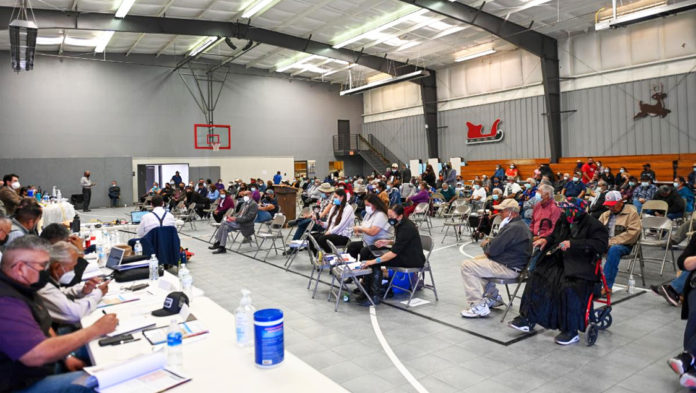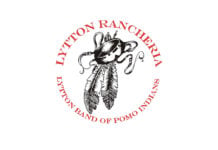
NAGEEZI, NM – Speaker Seth Damon and members of the 24th Navajo Nation Council were joined by Navajo Nation President Jonathan Nez for a tribal consultation meeting with the Bureau of Land Management (BLM) and the Bureau of Indian Affairs (BIA) in the community of Nageezi, NM. The hearing focused on the proposed 10-mile buffer zone around the Chaco Culture National Historical Park that will impact thousands of Navajo allottee landowners.
On November 15, 2021, the Biden Administration proposed a 20-year ban on oil and gas drilling within a 10-mile radius of the Chaco Culture Heritage Withdrawal Area in northwestern New Mexico. In January, the Department of the Interior (DOI) with the BLM published a notice in the Federal Register to withdraw approximately 351,000 acres of public lands and commence a two-year segregation while an environmental analysis is completed and public comment on the proposed administrative withdrawal is provided.
“As the governing body of the Navajo Nation, we state our opposition to the proposed withdrawal of federal lands without proper tribal consultation with the Navajo people,” said Speaker Seth Damon. “This action is another attempt to push multiple proposals while ignoring the voice of the largest tribal nation in the United States, whose aboriginal lands will be directly impacted. The official position of the Navajo Nation Council is to create a five-mile buffer within and around this sacred site. The Biden Administration must respect our tribal sovereignty and what the government-to-government relationship entails.”
As the primary stakeholder of trust, fee, and allotted land, the Navajo Nation has yet to be consulted by Interior Secretary Debra Haaland or the federal government since the White House announcement.
In 2020, the Navajo Nation received $434,000 from the Interior Department to conduct an ethnographic study to identify cultural resources of importance to the Navajo people in the Chaco Canyon region. This ethnographic study has yet to be completed as a unilateral decision regarding the area that has already been made.
“Chaco Canyon is located on Navajo land,” said Council Delegate Mark Freeland. “We will always stand alongside the Navajo people before other tribes. Our families who own allotments will be adversely impacted by the decisions of the Bureau of Land Management and Interior Secretary Debra Haaland. As leaders, we must hold the federal government accountable. We will always protect our natural resources and the voices of our people first.”
In 2020, the Naabik’íyáti’ Committee of the 24th Navajo Nation Council passed Resolution No. NABIJA-05-20 opposing H.R. 2181 and S. 1079 – “The Chaco Heritage Area Protection Act of 2019” – until a buffer zone surrounding the Chaco Culture National Historical Park was reduced to five miles.
“The voices of the Navajo people are valuable and powerful,” said Chairman Rickie Nez. “The Interior Department unilaterally made this withdrawal proposal without proper tribal consultation. Our families from the allotted land areas are ignored, and they deserve every opportunity to be heard now.”
On January 26, 2021, the Memorandum on Tribal Consultation and Strengthening Nation-to-Nation Relationships was signed by President Biden. This document directs all federal agencies to have meaningful consultation with tribes.
“Enough is enough on how the Navajo Nation is being treated,” said Council Delegate Kee Allen Begay Jr. “Secretary Deb Haaland has a trust responsibility to all 570+ Sovereign Nations and not just one tribal community. The federal government must follow the memorandum by President Biden that directs them to honor tribal sovereignty and include the voices of tribes in policy deliberations that affect our communities. Follow your own rules and guidelines issued.”
The administrative withdrawal of land currently impacts 53 individual allotments, generating $6.2 million a year in royalties for approximately 5,462 allottees. Many Navajo families rely on this income to meet their daily needs. It is estimated that 418 unleased allotments are also associated with about 16,615 allottees and could adversely affect well over 22,000 allottees.
“Natural resource extraction directly impacts our air, water, and land,” said Chairman Daniel Tso. “My chapters are seeking landscape protection of the Chaco Canyon region, and my understanding is that it is directly in opposition to what allottees want. Oil and gas operations on the sovereign land of the Counselor, Ojo Encino, and Pueblo Pintado Chapters are of major concern. As it stands today, individual allotments are not being prohibited from development. For the areas I represent, we believe further disruptions to the land caused by extraction is an environmental injustice to future generations.”
The White House maintains that this new rule would not apply to Individual Indian Allotments (IIA) or minerals within the area owned by private, state and tribal entities. However, the Navajo Nation Council believes the withdrawal would have a devastating impact because the indirect effects would make allotment lands worthless from energy extraction.
“The Resources and Development Committee agrees that Secretary Deb Haaland needs to listen to the concerns shared by the Navajo people first,” said Council Delegate Herman Daniels Jr. “It is completely false that if a company has a BLM lease, they can drill wherever they want and do whatever they want without regard for any archeological sites. Our Navajo allottees know their land and have rights, and we must respect that.”
Beginning in April 2019, the Resources and Development Committee (RDC) hosted three public meetings to hear the direct concerns of Navajo allottee families. In February, the committee was in Washington D.C. to advocate for the five-mile buffer zone for the Chaco Culture National Historical Park to Congress and the Biden Administration.
The BLM has initiated a 90-day public comment period. The public may submit comments on the proposed withdrawal until May 6, 2022. Comments may be submitted through ePlanning at: https://eplanning.blm.gov/eplanning-ui/project/2016892/510 or sent through the mail to: Bureau of Land Management, Farmington Field Office, Attn: Sarah Scott, 6251 College Blvd., Suite A, Farmington, NM 87402.












































